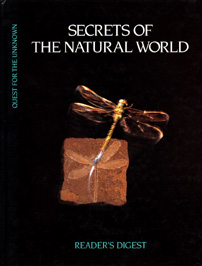
Secrets of the Natural World [a volume in the Quest For the Unknown series] (Reader's Digest Association, Inc: Pleasantville, New York, 1993; ISBN 0-89577-48-4). Consultant: Dr. Karl P.N. Shuker. Hb, 144 pp, colour pics, index.
Within its six beautifully-illustrated chapters, this compelling volume provides a uniquely thought-provoking, fascinating exploration of zoological, geological, and botanical mysteries that are still unexplained by conventional, traditional science.
Are certain animals able to hypnotise other animals? How could many spectacular creatures successfully elude scientific detection until as recently as the 20th Century, and do mystery beasts such as New Guinea's devil pig and Switzerland's tatzelworm comprise major new species still awaiting formal discovery? How can science explain spotted zebras, striped cheetahs, caterpillar-headed butterflies, rat kings, vampire moths, singing mice, and glowing owls? Chapter 1's survey of secret animals emphatically exposes an abundance of current zoological mysteries that are just as daunting but fascinating as those of the past.
Snakes that can perceive the infra-red body heat of their prey in total darkness, insects that are able to detect the secret ultraviolet pigmentation of flowers, creatures that can predict earthquakes, foretell changes in weather, prophecy death, and provide therapeutic assistance merely by their presence or touch, and birds that employ inexplicable navigational senses during their annual migrations. Chapter 2, examining mysterious senses in the animal world, reviews these and other riddles and revelations featuring 'animal instinct'.
In order to survive, animals tolerate and adapt to all manner of extraordinary circumstances, often in ways that remain mysterious even after intense scientific scrutiny. Chapter 3, investigating the secrets of survival, presents a compelling selection of examples, including creatures that have somehow become literally immune to conditions too adverse for any human to withstand, animals that thrive by embarking upon intimate but inscrutable associations with totally unrelated life forms, and species whose natural mode of existence involves spectacular mass swarms and often subsequent self-destruction.
Some of Nature's greatest mysteries highlight creatures not of the present but of the past. Why, when, and how did the dinosaurs die out? Could certain 'classic' extinct species of modern times have survived much longer than officially countenanced (perhaps persisting even today)? And might contemporary scientific researches one day resurrect extraordinary animals once thought to be irretrievably lost from the face of the Earth? These are some of the enigmas of extinction examined in Chapter 4 during the search for a plausible solution.
The extraordinary world of plants is the subject of Chapter 5, proffering a harvest of controversial cases from the annals of botanical lore - ranging from mysteries of plant behaviour, and flesh-eating flowers, to herbal traditions, and a pharmacopeia of the future.
The wonders of sea and earth are pursued in Chapter 6, disclosing such marvels as a recently-discovered community of bizarre animals living on the sea bottom in total autonomy from the rest of the planet and never before seen by man, ringing rocks and singing sands, lethal tides of blood, incandescent oceanic wheels of light, and the revolutionary Gaia hypothesis - proposing that our entire planet is, in effect, a living organism.
Contributors: Dennis Bardens, Michael Bright, Peter Brookesmith, Professor John L. Cloudsley-Thompson, Nicholas Jones, William Lindsay, Dr. Malcolm MacGarvin, Lesley Riley, Dr. Karl P.N. Shuker.
| Books | Man and Beast | Secrets of the Natural World | Almanac of the Uncanny |
| Home | Biography | Books | CZ Bibliography | Sightings | Links |
Web Design: Scott T. Norman